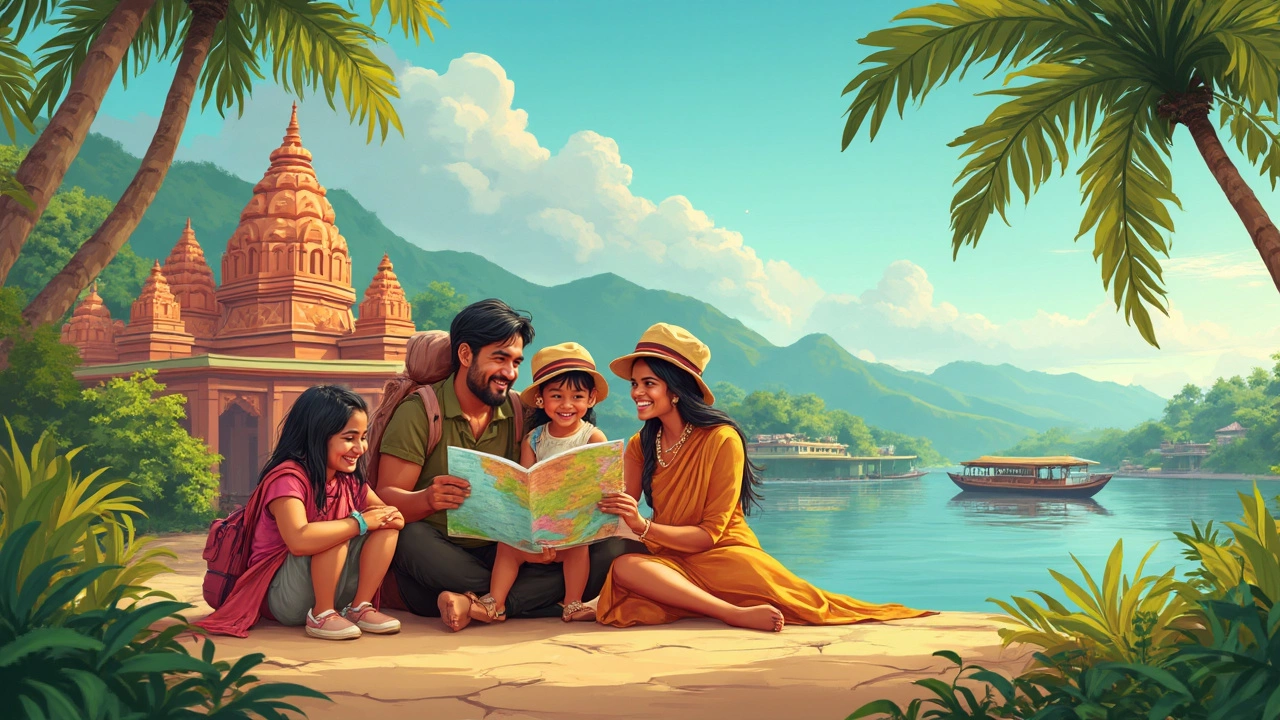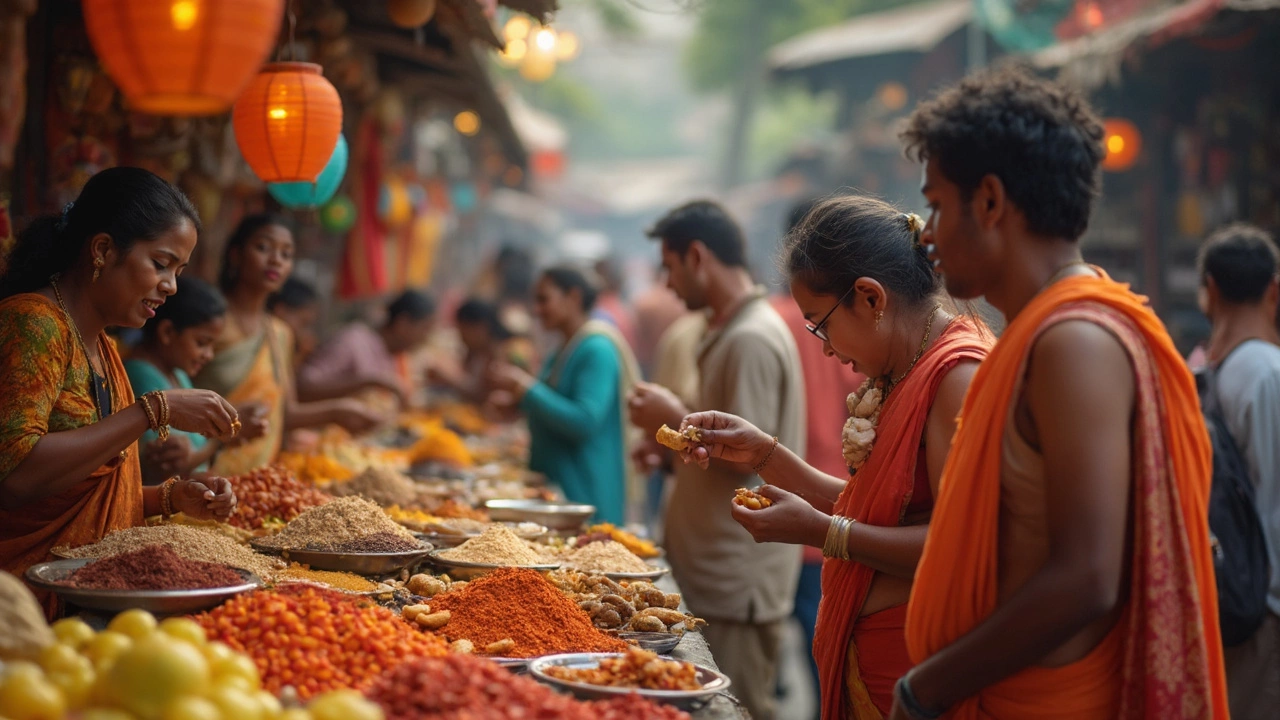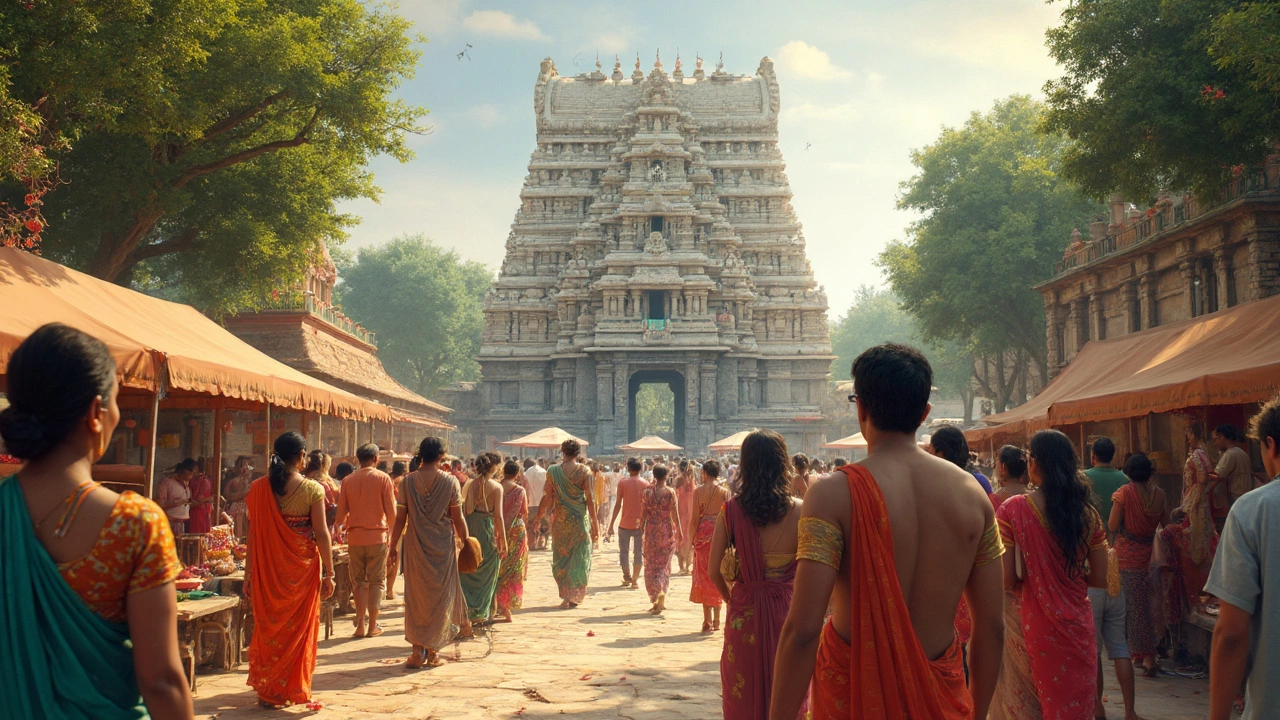South India Trip Planning: A Practical Guide for First-Timers

A South India trip can feel like a maze. Between lush green hills, lazy beaches, ancient temples, and spicy food, it’s easy to get overwhelmed. Your head goes, How do I even start?
Don’t let the chaos scare you off. With a bit of smart prep, you’ll dodge tourist traps, avoid endless bus rides, and actually have time to soak in those chill Kerala backwaters or get lost in a Bangalore street-food market. Timing matters too—monsoon can turn a dream trip into a soggy slog. And if you’re a parent like me with a kid who’s obsessed with elephants, trust me, it pays to pick the right spots ahead of time.
This article lays out every step, from the moment you ask, “How much will this cost?” to when you’re picking a local SIM card and debating between dosa or biryani for dinner. Ready to cut the confusion? Let’s get your plan sorted.
- Setting Your Budget and Timing
- Choosing Your Destinations
- Building Your Itinerary
- Transport: Getting Around South India
- Where to Stay and What to Eat
- Family Travel Hacks and Common Pitfalls
Setting Your Budget and Timing
Let’s get straight to it. Before you daydream about South Indian road trips or all those Instagrammable temples, nail down your budget and timing. These two things will shape the rest of your planning.
South India isn’t just one size fits all—places like Goa or Kochi can be twice as pricey during peak season. On the flip side, hitting places during monsoon (June–September) can drop prices by 30% or more, but you might get drenched walking from your hotel. For most people, November to March is that sweet spot—clear skies, manageable heat, and loads of festivals.
If you’re traveling with family or kids, avoid holidays like Christmas or Pongal (mid-January)—that’s when train tickets vanish in hours and hotel prices spike big time. Try to plan at least three months early for the best rates, especially if you care about getting decent trains or comfy stays.
Your South India trip can work on almost any budget, but it helps to know what you’re in for. Here’s a rough idea of daily costs per person (in Indian rupees, so you can swap out currencies easily):
| Budget Type | Accommodation | Food | Transport | Total/Day |
|---|---|---|---|---|
| Shoestring/Backpacker | ₹500–₹800 | ₹200–₹400 | ₹100–₹300 | ₹800–₹1,500 |
| Mid-range | ₹1,200–₹2,500 | ₹500–₹1,000 | ₹400–₹900 | ₹2,100–₹4,400 |
| Comfort/Luxury | ₹4,000–₹12,000 | ₹1,500+ | ₹1,000+ | ₹6,500 and up |
Keep a little extra for entry fees (₹50–₹600 for major attractions) and, of course, the never-ending snack pit stops. If you’re booking private taxis or guided tours, costs can double fast.
One tip: Flights into cities like Chennai or Bangalore are usually cheaper than smaller airports. If the calendar is flexible, book mid-week flights for better deals. And if all else fails, overnight trains are cheap and let you wake up in a new city (plus, kids think it’s an adventure).
So bottom line: decide when you want to go based on weather and crowds, check prices, and set your daily budget. Get these two sorted, and the rest falls into place way easier.
Choosing Your Destinations
South India isn’t just one thing—it’s hundreds of different experiences stacked into a patchwork across five wildly different states: Kerala, Tamil Nadu, Karnataka, Andhra Pradesh, and Telangana. Trying to pack all of it into a single trip? Don’t. You’ll wind up exhausted and frustrated. Instead, focus on what excites you or your family most, then build around that.
- Kerala: If you want lush greenery, backwaters, and quiet time, check out Alleppey or Kumarakom for houseboats. Tea fans love Munnar’s rolling plantations, and wildlife buffs should aim for Thekkady or Wayanad. Kochi is your spot for history and hip cafes.
- Tamil Nadu: For classic temples and ancient culture, you can’t miss Madurai’s Meenakshi Temple (more visitors per year than the Taj Mahal!) or the rock carvings at Mahabalipuram. Chennai is the urban gateway, but Pondicherry gives off a calm, French vibe by the sea.
- Karnataka: Tech meets tradition in Bengaluru—perfect for foodies and night owls. Want ancient ruins? Hampi is unbeatable. Mysuru’s palace lights up at night and Coorg is known for its coffee and hilly escapes.
- Andhra Pradesh & Telangana: History fans rave about Hyderabad’s old city, Charminar, and the legendary biryani. For Buddhist sites, Amaravati stands out. Don’t overlook dramatic hill stations like Araku Valley.
Not sure which vibe fits? Here’s a quick cheat sheet:
| State | Type of Place | Big Attractions |
|---|---|---|
| Kerala | Nature, Relaxation | Alleppey, Munnar, Kochi, Thekkady |
| Tamil Nadu | Culture, Architecture | Madurai, Chennai, Mahabalipuram |
| Karnataka | Food, Heritage | Bengaluru, Hampi, Mysuru, Coorg |
| Telangana | History, Cuisine | Hyderabad, Warangal |
| Andhra Pradesh | Nature, Pilgrimage | Tirupati, Araku Valley, Amaravati |
If you’re squeezed for time, stick to one or two states. For first-timers, Kerala’s easy-going vibe and Karnataka’s food scene tend to win people over. And here’s an underrated tip: weekdays are quieter almost everywhere. Avoid big religious festival dates unless you want crowds.
When putting your South India trip together, always check distances on Google Maps—roads can be windy and slow. Sometimes, 100 kilometers means four hours of travel. Prioritize what fits your interests instead of running around for bragging rights. You’ll remember the chilled chai in Coorg or that sunrise over Varkala Beach way more than checking boxes off a list.
Building Your Itinerary
Making a good South India trip plan is way easier if you break it down step by step. Start simple. How many days can you spare? South India is huge—think four states, thousands of kilometers, and more flavors than your local buffet. For first-timers, anywhere from 7 to 14 days is realistic if you want more than just bus-window views.
The region covers Karnataka, Kerala, Tamil Nadu, and Andhra Pradesh. Each has its big draws: Kerala for backwaters and wildlife, Tamil Nadu for temples and heritage cities, Karnataka for hip cities and waterfalls, and Andhra if you’re chasing spicy food and less-touristed beaches. Most travelers try to squeeze in at least two states.
Here’s how to start building that itinerary:
- Map must-sees. These are your top picks—maybe the Meenakshi Temple in Madurai, the tea hills of Munnar, Hampi’s ruins, or chill days on Varkala Beach. Limit big travel days, especially if you have kids (or hate repacking every morning).
- Plot your route sensibly. Major cities like Kochi, Chennai, Bangalore, and Hyderabad have international and domestic airports. Fly into one, then plan a loop rather than a zigzag—this saves loads of time and money.
- Mix it up. After a steamy day in Chennai, you’ll crave the cool Nilgiri hills or a shady river cruise in Kerala. Don’t stack all your temple-hopping together unless you really love ancient stones.
- Pace is key. Avoid the rookie mistake of stuffing too many places in. South India distances are deceiving—a 150 km drive can take five hours if you hit mountain roads or cows blocking traffic. Aim for no more than two long travel days per week if you want this to feel like a vacation.
- Add buffer days. Trains run late, and monsoons don’t care about your plans. If you’re flying home from Bangalore, make sure you don’t have a 10-hour train journey the day before.
Need some trip ideas? Here are realistic sample itineraries for different trip lengths:
| Days | Sample Route | Main Highlights |
|---|---|---|
| 7 | Kochi – Munnar – Alleppey – Varkala | Backwaters, tea gardens, beaches |
| 10 | Chennai – Mahabalipuram – Pondicherry – Madurai – Thekkady – Kochi | Temples, French town, wildlife, food |
| 14 | Bangalore – Mysore – Coorg – Wayanad – Ooty – Cochin | Palaces, coffee plantations, national parks, cool hill stations |
Book hotels near action spots—staying right in Fort Kochi, near Madurai’s temple, or smack in Varkala’s clifftop guarantees you spend less time in traffic and more time doing, well, South India stuff. Lock in train tickets early; they sell out weeks, even months, ahead. And double-check opening hours for popular sights—some, like Mysore Palace, close afternoons.
If you’re a foodie (or have a picky eater tagging along, like my daughter Evangeline), plan food stops for idli breakfasts and endless banana-leaf thalis. Every region’s got special snacks—don’t miss them just because you didn’t plan ahead.

Transport: Getting Around South India
Traveling around South India isn’t complicated if you know your options and book early, especially in peak season. The biggest cities—Chennai, Bangalore, Kochi, and Hyderabad—are well-connected by flights, trains, and buses, so you can get from one state to the next without much hassle. For moving between those major stops, domestic flights are the fastest. IndiGo, Air India, and SpiceJet have regular routes, and if you book a few weeks out, tickets can be downright cheap.
If you want to see the landscape and save money, Indian Railways is your friend. South India’s train network is huge—there’s no better way to watch palm trees and rice fields blur past your window. Second class AC (2A or 3A) is comfy and safe enough for families. Sleeper class might sound adventurous, but it can get packed, so only try it if you don’t mind crowds.
For shorter distances or off-the-map destinations, long-distance and private buses fill the gaps. The Kerala and Karnataka state buses cover most towns and are cheap, but expect bumpy roads and delays. If you want a little more comfort, check for private Volvo buses—RedBus is the app almost everyone uses to book seats.
In cities and smaller towns, auto rickshaws and app-based taxis (like Ola and Uber) are the easiest way around. Always ask to use the meter in rickshaws, but be ready to negotiate a bit—some drivers just quote random prices if they spot a tourist. If you’re feeling brave and know how to handle Indian roads, renting a scooter in places like Goa or Pondicherry can be a blast, but don’t forget your international driving permit and helmet.
Here’s a quick comparison to help you choose:
| Transport Mode | Best For | Average Price (2025) | How to Book | Speed |
|---|---|---|---|---|
| Flight | Long distances, saving time | ₹1,800-₹4,000 (one-way) | Airline sites, MakeMyTrip | Fastest |
| Train (2A/3A) | Interstate travel, scenery | ₹700-₹2,000 | IRCTC, RailYatri | Moderate |
| Private Bus (Volvo) | Flexible routes | ₹600-₹1,500 | RedBus app, operator sites | Varies |
| Auto Rickshaw | Cities, short hops | ₹30-₹150 (per trip) | On the spot | Quick for short trips |
| Scooter Rental | Coastal towns, freedom | ₹400-₹600 per day | Local rentals | Depends on traffic |
Pro tip: trains and flights sell out fast for holidays, so if your South India trip falls around Christmas or summer vacations, snap those tickets as soon as your dates are set. Also, the South India trip will be a lot smoother with Google Maps offline and the Paytm app for mobile payments, since card machines sometimes act up out here.
Where to Stay and What to Eat
Let’s break it down: Where you crash and what you eat on your South India trip matters more than you think. Book the wrong place or order the wrong dish, and you’ll remember it for all the wrong reasons. Here’s how to make smart choices, whether you’re a budget backpacker or traveling with a picky eater.
Where to Stay: South India has everything—from luxury hotels in Chennai to hammocks in a Kerala homestay. Fancy hotels come with air conditioning, great WiFi, and reliable water—lifesavers in summer. If you want something more personal, homestays and guesthouses are big here, especially in Kerala and Coorg. You’ll probably eat home-cooked food and maybe even get local travel tips from your hosts.
- Luxury Hotels: Think Taj, Leela, or ITC in big cities—perfect if you need comfort.
- Homestays: Kerala is famous for these; they’re great for families and those wanting a local touch.
- Hostels and Guesthouses: Good for solo travelers and anyone on a budget. Zostel and Backpacker Panda have decent ratings.
- Heritage and Eco Stays: In places like Pondicherry or Madurai, some old colonial houses turned hotels offer character and charm. Eco resorts in Wayanad or Thekkady put you near the forest.
Always check the A/C and hot water situation, especially from March to May—it gets brutally hot. For families, I learned the hard way: book a place that guarantees early check-in, or you’ll have tired kids nodding off in the lobby (thanks, Evangeline!).
What to Eat: Eating local isn’t just about ticking boxes—it’s half the fun. South Indian food is way more than just idli and dosa. Each state cooks up its own specialties, and you’ll want to try a few. Here’s a quick cheat sheet for must-eats by state:
- Tamil Nadu: Dosa, sambar, filter coffee—basic but epic. Try Chettinad chicken if you like spicy food.
- Kerala: Appam with stew, fish curry—super fresh and full of coconut. Don’t skip Kerala Sadya, a veggie feast served on a banana leaf, especially during festivals.
- Karnataka: Bisi bele bath (rice dish), Mysore masala dosa, and ragi mudde (finger millet balls with spicy sambar).
- Andhra Pradesh & Telangana: Hyderabadi biryani, gongura pickle, and spicy curries—if you can take the heat!
- Pondicherry: Try the French-Indian café scene: crepes, baguettes, and strong coffee.
If you’re nervous about street food, stick to places with a crowd—locals won’t queue for bad food. And always drink bottled water, even in fancier restaurants. A lot of eateries do "meals" for lunch (unlimited rice and sides) for cheap, usually under ₹150 ($2). Here’s a quick table to give you an idea of meal costs:
| Type of Place | Average Meal Cost (INR) | Notes |
|---|---|---|
| Street Food | 50-100 | Cheap, tasty, popular with locals |
| Veg Restaurant | 100-300 | Safe, air-conditioned in cities |
| Non-Veg Restaurant | 200-500 | Wider menu, can try local meats/seafood |
| Hotel Buffet | 500-1500 | High-end, good for big groups |
Vegetarians have it easy almost everywhere. For allergies, ask for "no nuts" (the word is "mundhiri" in Tamil). And if your mouth’s on fire? Order some curd (yogurt)—it cools everything down fast. Don’t forget to grab a South Indian filter coffee after your meal—locals swear by it to recharge for more exploring.
Family Travel Hacks and Common Pitfalls
Bringing kids to South India can be a blast, but it can also make you sweat—literally and figuratively. South India is hot almost all year, especially from March to June. Hydration is key. Carrying a refillable water bottle changes everything, especially if your kids get cranky in the heat. When traveling with little ones, ask if your hotel or guesthouse offers child-friendly meals and a reliable crib. Many city hotels do, but homestays might not be so prepared.
Power cuts are pretty common in rural spots. Bring a power bank and maybe a small flashlight. If you’re worried about clean food, stick to places busy with locals. As my daughter Evangeline found out, the dosa stalls with a line rarely disappoint.
"Traveling in South India with children is perfectly doable if you prepare for the basics: heat, food, and downtime. Kids love the chaos of Indian cities, but they need time to unwind, too." — Lonely Planet South India Guide 2023
If you're visiting temples, remember: proper clothing matters. Both adults and kids have to cover shoulders and knees. Footwear will likely need to come off at temple doors, so slip-on shoes beat sneakers with double knots.
- Always pack extra wipes. Handwashing stations aren’t everywhere.
- Download Google Maps offline. Patchy mobile data is a thing outside big towns.
- Book first train rides in advance—kids find Indian trains super exciting, but seats run out fast.
- Bring a simple medicine kit: think rehydration salts, fever reducers, and something for upset stomachs. Pharmacies are everywhere, but few have English signs.
Here’s a quick look at the most common pitfalls parents run into:
| Pitfall | How to Avoid |
|---|---|
| Overpacked Itinerary | Plan no more than 1-2 big activities per day. Kids need downtime. |
| Eating Street Food Carelessly | Go where locals eat and skip salads and ice unless it’s bottled. |
| Heat Exhaustion | Dress light, drink water, and schedule outdoor stuff early or late. |
| Long Distance Journeys | Break up travel with short stops: parks, beach, or a temple. |
| Cultural Slip-ups | Research temple etiquette and local customs before visiting. |
The golden rule? Flexibility. Trains can be late. Rain can pour. Kids might fixate on an elephant camp you didn’t plan for. With the right mindset and these family-tested tricks, you’ll keep the South India trip fun, safe, and memorable for all.

